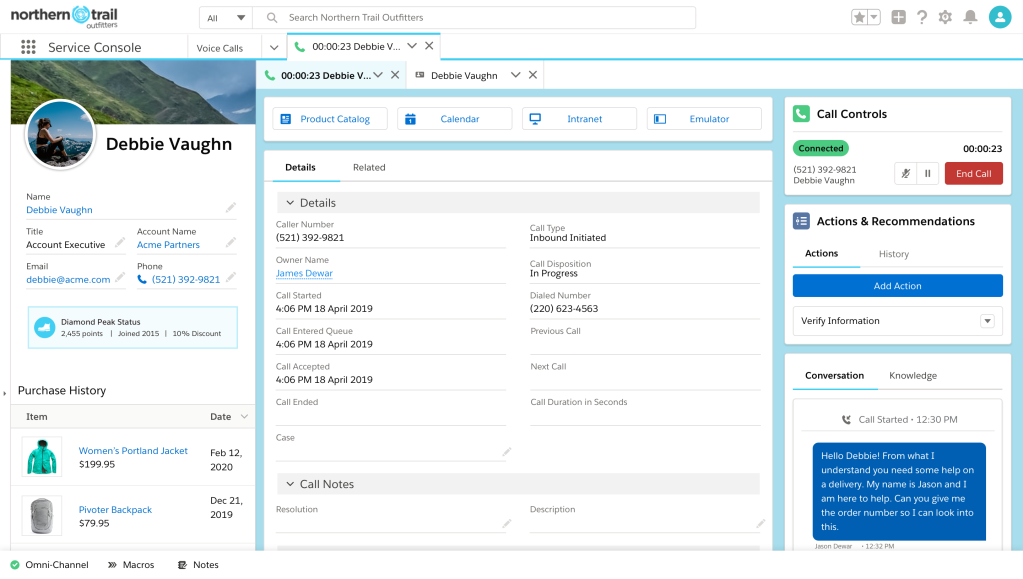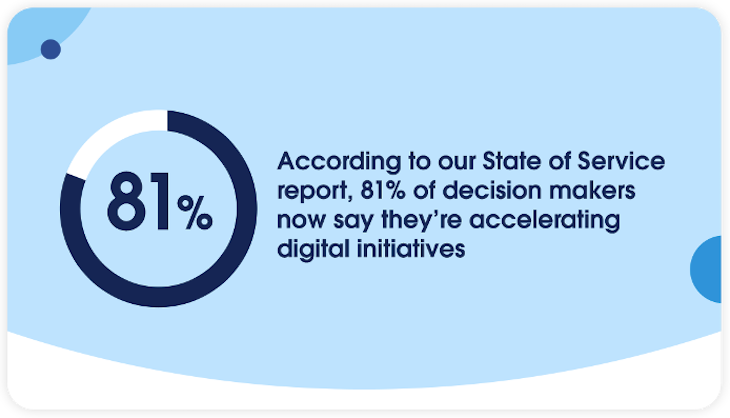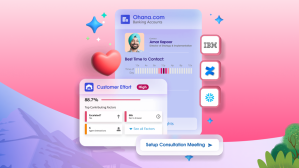With wide-scale vaccinations within sight, business leaders must now seize the moment of reopening with both customers and employees. After hunkering down for over a year, people are craving in-person experiences. 96% of consumers plan to shop inside a brick-and-mortar store by the end of this year. Three-quarters plan to stay in a hotel or vacation rental. Sectors such as airlines, hospitality, entertainment, and transportation will come roaring back to life as billions of people around the world begin to travel again, visit museums and baseball games, and go to dentist appointments they’ve held off on for a year.
“The state of service has changed, and many of the changes will be permanent.”
Clara Shih, CEO, Salesforce Service Cloud
For Service Cloud customers like Sonos, Marriott Hotels, and The Container Store, this pent-up demand creates an opportunity not only to resume pre-pandemic life, but to reset and reinvent what the post-pandemic era will be. Though in-person experiences are in high demand, digital conveniences and behaviors customers grew accustomed to during lockdown are here to stay. The majority plan to continue using curbside pickup or delivery, contactless payments, and online booking– even in-person experiences will have digital elements. The state of service has changed, and many of the changes will be permanent.
Here are three permanent shifts which leaders of all organizations should consider.
First, the shift to all-digital
A year ago, the world went into lockdown. Business leaders scrambled to pivot their organizations to work-from-home. Across sectors, contact centers were flooded with calls about flight and hotel reservation cancellations, shipping delays, mortgage payment relief, unemployment benefits, questions about Covid symptoms. A lot of the questions and issues people had traditionally gotten answered in brick-and-mortar stores, such as product availability or product returns, were suddenly all diverted to the call center. Call center agents, suddenly working from their kitchen table, simply could not keep up with the surge in call volume. Customers had to wait on hold for hours to speak to a service agent. Something had to give.
“Overnight, the world shifted profoundly – and irreversibly – toward digital engagement, self-service, and automation. The impact on the world of customer service and support has been enormous.”
Clara Shih, CEO, Salesforce Service Cloud
Overnight, the world shifted profoundly – and irreversibly – toward digital engagement, self-service, and automation. The impact on the world of customer service and support has been enormous. At Salesforce, we’ve seen a 706% spike in Einstein Bot sessions over the past 12 months and a similar surge in customer mobile and web chat, messaging, and email. In parallel, we’ve seen the rise of the ‘Appointment Economy,’ empowering customers with the speed, ease, and convenience of scheduling in-person interactions from delivery and curbside pickup to in-store shopping while ensuring proper social distancing. Instead of what were previously ad-hoc interactions, people now choose to schedule appointments ahead of time for everyday events and activities like going to the zoo or a retail shop.
The exciting thing is that digital capabilities are no longer limited to large enterprises. Service Cloud is built 100% on Salesforce Platform, the original no-code platform, which means companies don’t need to have a huge team of data scientists and engineers in order to digitally transform with messaging, chat, and bots. With just a few clicks, even the smallest business can have its own customer service bot with our new Pre-Built Einstein Bots.
Little wonder that 81% of decision makers at organizations large and small interviewed for our State of Service report say they’re accelerating digital initiatives, and 78% of them say they’ve invested in new technology as a result of the pandemic. A major driving force behind the adoption of digital channels has been the need for call deflection, to address the surge in call volume and customers demanding instant answers and fast resolution.
A key lesson learned about digital initiatives has been just how important it is to have all of your organization’s omnichannel touchpoints unified and orchestrated from a single source of truth. Companies using one vendor for bots, another vendor for messaging, and yet another provider for their self-service portal, took a big hit in customer satisfaction (CSAT) scores, as customers found themselves having to repeat the same information each time they were handed off or escalated to another siloed channel.
The pandemic has accelerated the need for a true omnichannel architecture based on a 360° view of the customer. So when a customer starts a support interaction by chatting her request to a bot to change the shipping address of her order, but then gets transferred to a human agent, all of that context gets passed to the agent, along with the fact that this customer engaged with an ad for additional products. The customer does not need to repeat herself, and suddenly, the lines between digital service and the call center, and between sales and service blur as the service associate helps cross-sell the customer after resolving her shipping request.
“The future of work is playing out before our very eyes. This is a totally new era of contact centers. We’ve seen the old ways of working die out.”
Clara Shih, CEO, Salesforce Service Cloud
Look at CarMax, one of our customers. In a span of just three weeks, they launched CarMax Curbside, a capability that lets customers test-drive and buy a car in a contactless, socially distanced way. CarMax also completed the rollout of their home delivery option, now available to most customers. Buyers save time by completing most tasks on CarMax’s website, including picking a car, applying for financing and getting a trade-in offer on their current vehicle.
It’s a great example of removing friction and making things easier and more convenient for customers in today’s all-digital world.
Second, data-driven call center reinvention
CEOs have known for years they need to think differently about their call center. COVID has acted as a forcing function. The pressures and changes wrought by COVID – and the emergence of social distancing restrictions – are a catalyst for the industry to reinvent. When you hear about these large banks, healthcare providers, government agencies forcing customers to wait one, two, three hours, sometimes longer, we all intuitively know that is an awful customer experience and that there is a better way forward.
Before COVID, the conventional wisdom was that call center agents had to be on-site. The last year has proven this to be untrue. COVID exposed an opportunity to deliver great service from anywhere. Suddenly, companies can look for talent anywhere. They can hire people who need to be home– providing greater access to service job opportunities to women, who bear the brunt of child care and elderly care.

The future of work is playing out before our very eyes. This is a totally new era of contact centers. We’ve seen the old ways of working die out. The ways customer service teams used to work – with agents handling only one support channel, turning to their colleague in the next cubicle to ask for help, or supervisors walking the halls to look for opportunities to help – have gone out the window as service operations moved out of the contact center and into the kitchens and living rooms of agents, supervisors and dispatchers. Instead, Service Cloud Voice is transcribing calls in real time, offering agents in-the-moment guidance on next steps and proactively escalating to their supervisor if the agent gets stuck. When a customer says an order number, it’s automatically recognized and the order is automatically pulled up on the agent’s screen. Instead of frantically typing, the agent can focus on relationship-building with the customer and building a human connection. On-the-job training and experiences are being transformed by Service Cloud Workforce Engagement, our new workforce planning product that uses AI to help service leaders staff the right teams and deliver personalized training to agents to continuously upskill.
Third, ramping field service
As the world begins to reopen, office buildings, sports stadiums, and malls will need to ramp up to address throngs of people excited to be back together in the community again. Sectors including food service, manufacturing, sanitation, and utilities in particular are increasing their use of Salesforce Field Service to prepare for the surge in infrastructure and servicing demands– everything from elevator maintenance, lights and air quality systems as people return to work, to concert and sports venues, airports, and museums. These indoor spaces have largely sat vacant for the last 12 months, and require checks and maintenance before they are ready for prime time.
As companies continue to limit in-person site visits and prioritize employee health and safety, delivering trusted and effective visual support will remain important. Mobile technicians can reduce time on site by using Visual Remote Assistant, which allows techs and agents to see what the customer sees through video support, so they can resolve complex issues from anywhere.
Society’s reinvention moment
As we reflect on the past year and look ahead to the future, I marvel at the resilience, creativity, empathy, and courage that our customers have led with. This was the year that changed everything and everyone. Each of us has been tested in ways previously inconceivable, and as a result, none of us will exit the pandemic the same way we came in.
Resuming pre-pandemic life would be an opportunity missed to rethink and reinvent. This is a reset moment for every individual and every organization. To shift from siloed thinking to connecting the dots. To question previous assumptions. To optimize for relationships, not transactions. To treat our customers not as order numbers but as partners for the long haul.
“The digital transformation of service is happening in weeks and months, not years. And that transformation is changing the role of service organizations and service leaders.”
Clara Shih, CEO, Salesforce Service Cloud
The digital transformation of service is happening in weeks and months, not years. And that transformation is changing the role of service organizations and service leaders. To succeed now and going forward, we need to operate in new ways. For the best companies, COVID and the great reopening before us are a catalyst for comprehensive and permanent digital transformation of customer service and the future of work.




















